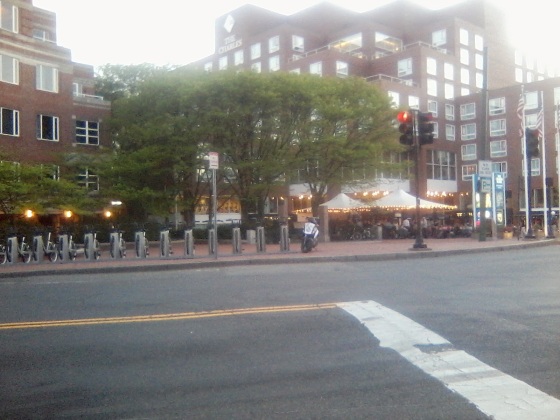
A recent edition of a local cycling newsletter had a blurb about the Boston bike share’s expansion into several new towns. These towns are all located outside of Boston proper. Providing bike share stations in these areas significantly widens the travel area available to the program’s riders. It also makes commuting all or part of the way to work by bike a viable option for suburbanites.
All of the suburbs mentioned are nice neighborhoods, but one in particular stood out. It was the City of Newton, Massachusetts. What’s unusual about this city is that it’s more affluent than most Boston suburbs. It’s not the first place you’d think of in relation to a bike share program.
Something about affluent communities makes them seem as if everyone who lives there has their own belongings and does not want or need to share anything. Yet, the Hubway bike share program will be installing stations there in 2014.
Newton is filled with cyclists. Most of them cruise by on shiny, expensive bikes, looking like they just rolled off of a bike shop floor. With the exception of the commuters, everyone appears to be exercising. Are these the people who will use the bike share? Or are the potential riders people we never see on bikes?
Placing stations in Newton is a good idea, even if many of its residents own expensive bike. The city has a large student population. Each of its 13 villages has a central area where locals shop and dine out. The village centers tend to get quite busy. They are the areas locals are most likely to travel to if they decide to rent a bike share bike.
The cyclists are there. The proximity to Boston and Brookline, which sits between Newton and Boston, would allow riders to travel through all three areas. This is certainly practical. But is it the reason Newton was selected as one of the expansion towns?
Whoever decides these things must have a formula for deciding where to place the stations. Proximity to existing stations would seem to factor heavily into a decision to include a new area.
Most riders take short rides with bike share bikes, so the stations shouldn’t be too far apart. Still the travel areas should be wide and contiguous to encourage people to ride more places by bike.
After proximity, demand might come into play. To become a bike share town, a community would have to demonstrate a substantial ridership and evidence that people who don’t ride regularly would be interested in renting a bike from time to time.
In urban areas, demand can be assumed due to the density of the population and the number of people who walk or ride public transportation rather than driving a car. But in the suburbs it’s more difficult to gauge this sort of thing.
Places like Newton have active local bicycle advocacy groups. Such groups might be one way to make suburban demand known. Statistics on ridership could be collected or polls asking about interest in a bike share could be organized and implemented. In this way, local riders could put their town on the radar of the bike share organizers.
Even though proximity and demand seem to be dominant forces in bike share program success, the question of socioeconomic trends must factor in. Many people would associate cycling and bike sharing with less affluent socioeconomic groups.
Bikes seem to be tied to the idea of indigence. In American culture, cars are associated with affluence and inexpensive forms of transportation like bikes are seen as transportation for those who cannot afford a car. Despite this association, cycling has become increasingly popular with more affluent socioeconomic groups.
Health, environmental concerns and convenience have made cycling more popular among people who can afford cars. In fact, it might be said that affluent people have become more interested in cycling than poor people. This can be seen in the number of bike to work or school programs cropping up in affluent suburbs. Group rides have become more popular in those areas too.
For a bike share to work in the long run, it must consider practicality, demand and trends. Positioning stations to meet demand and to make it possible for riders to get where they want to go takes planning and re-planning. The practicality of the locations, based on proximity to each other and to frequently traveled places must also be considered.
What’s less obvious is the need for a bike share to span all socioeconomic brackets. Shared bikes must be made available for rich and poor alike. Bike sharing can’t be done in isolation. If cycling is ever going to become a mainstream form of transportation then riders from all walks of life must have access to bikes. And what better way to give them access than to put bike share stations in their neighborhoods.
Putting bike share stations in affluent neighborhoods might seem counter-intuitive at the outset, but it’s really necessary for including everyone in bicycle transportation and for allowing travel across and between neighborhoods. It will be interesting to see where they position the bike share stations in Newton. And it will be worthwhile to see how the bike share program is utilized, in general, once more suburbs are added to the equation. Only time will tell whether socioeconomic trends, proximity, or demand play a larger role in the long-term success of a bike share. We will have to wait and see.


